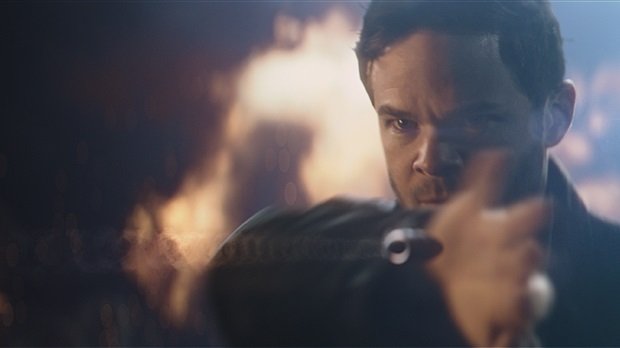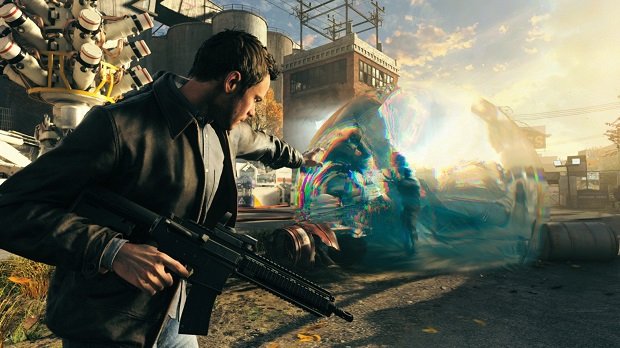Quantum Break is the logical next step in Remedy's TV obsession
Quantum Break launches on PC and Xbox One in a handful of weeks, and aims to give players a mix of third-person, time-bending gunplay along with a strange, distinctly un-video game focus on lengthy full-motion video cut-scenes starring big-name Hollywood actors. It feels weird to even say that now, a few years after it was first announced - like it's a game from an alternate universe where Mad Dog McCree was as influential as Super Mario Bros., where the Xbox One actually became the definitive All-In-One Entertainment Center and didn't shut down its entertainment initiative shortly before launching its Halo television series.
- Vote for Quantum Break in the Best Xbox Game category at the upcoming Golden Joystick Awards 2016 and claim three games for $1 / £1 for taking part.

It would be weird, that is, if we were talking about any other developer in the world. Quantum Break comes from Remedy Entertainment, the creators of modern classics like Max Payne and Alan Wake. Once you realize who is behind Xbox's upcoming shooter, it's easy to see why this bizarre television experiment makes total sense: Remedy's games, stories, and characters are all obsessed with television, and Quantum Break represents the logical conclusion of the studio's unique approach to video game storytelling.
Remedy's had Hollywood aspirations ever since the release of its breakout hit, Max Payne. The game itself is a pastiche of film noir, Hong Kong action cinema, and graphic novels, as our titular hero monologues his way through a series of high-octane gun battles and convoluted subplots. But the game is always winking at the player, its references proudly worn on its sleeve accompanied by the sly (possibly constipated?) grin of its protagonist. This was a game that began to deconstruct itself at the end of the second act, as Max runs through a seemingly neverending loop of misery during a drug-induced nightmare, believing himself to be stuck in a graphic novel or a computer game.
Outside of all the violence, the melodrama, the cursing, and other adult content, there's Lords and Ladies, a fictional television show our anti-hero stumbles across during his quest for revenge. The show pops up during brief moments of calm, providing a respite from all the wanton killing with a story of Victorian-era royalty getting into incredibly polite mishaps. The videos of each episode are crude, portrayed via audio playing over a slide show of what is most likely the game's developers dressed up in bad costumes, but this series of one-off jokes would go on to form the very backbone of Remedy's storytelling going forward.
Max Payne 2 filled its version of New York City with several other TV shows, but rather than acting as a form of escapism for its denizens, it held a mirror up, allowing us a glimpse at the demons that lurked outside of its edges. The show Dick Justice is a cheeky retelling of the first Max Payne, done in the style of a 1970s cop drama. Then there's The Adventures of Captain BaseBallBat-Boy, a seemingly innocent kid's show filled with demons and zombies; a favorite of Vinnie Gognitti, one of the most notorious mobsters in New York. Address Unknown, however, shows Remedy at its most demented, telling a Twin Peaks-inspired tale about a man who hunts for a serial killer while a pink flamingo gives him cryptically backmasked messages.
The TV shows in Max Payne aren't just a way for Remedy to add some color to the universe it's created, though they most certainly do that; these shows bleed out from the TV and into the game's environments and level design. One of the levels in Max Payne 2 takes place in an abandoned funhouse based on Address Unknown, filled with smoke, mirrors, and rotating hallways; another has you protecting Gognitti from attack while a giant BaseBallBat-Boy mask rigged with explosives is strapped to his head. These shows are violent, with a sinister streak a mile wide, and they're as much a part of Max Payne's world as Marvel's superheroes are to ours.
And then there's Alan Wake, which makes the leap from static images to full-blown video, taking the Twin Peaks vibe Remedy explored with Address Unknown and turning it into its own story. Accompanying the video game's story are several opportunities to watch television, whether it's an old episode of the Twilight Zone-inspired Night Springs that Wake once wrote for, or a recording of a talk show, or the bizarre playback of Wake himself stuck inside the cabin, forced to write for a malevolent presence. It's interesting that these videos are portrayed with real actors, with real sets, as if these TV screens represent a reality more 'real' than the game you're currently playing. And yet, there's a dreamlike quality to these moments too, as the dubbing is off just enough and the production values just cheesy enough to make you feel uneasy about what you're watching.
Weekly digests, tales from the communities you love, and more
It makes their appearance in the quasi-sequel American Nightmare all the more frightening, as that game ditches the re-runs for a series of intimate videos featuring Mr. Scratch, Alan Wake's sadistic, slick-haired doppelganger. Mr. Scratch is out there in the real world, attempting to infiltrate your circle of friends, while you're stuck in this video game filled with shadow demons - his existence as a real actor makes you question your own place within the narrative, if what you're doing is just another fiction devised by the dark presence while your asshole twin goes out and murders people in real life. And your weapon to fight against the darkness? A movie created by your wife and entered into a small Arizona town film festival, blown-up on a drive-in movie theater screen.
Many video games attempt to ape that Hollywood blockbuster style, but Remedy is the rare developer that actually uses that style, along with an entire history of classic films, cult television, and horror novels, to say something about the worlds it creates. Its games are obsessed with media and the implication of the meta-layers of media inside other media. Its characters, too, are just as obsessed, talking about these shows you watch in-game, spoiling the endings to each other, finding themselves wrapped up in irrational fandom and obsession with its creators. But rather than turning its nose up at this obsession, Remedy approaches it with open arms, even going so far as to structure Alan Wake episodically, complete with television-style breaks and cliffhangers. These games long to be your next binge-worthy television show, but unlike so many others, are successfully able to navigate that thin line between their own filmic aspirations and the interactive nature of video games by making them one and the same.

So of course Quantum Break stars Iceman (Shawn Ashmore) and Merry from Lord of the Rings (Dominic Monaghan). Of course there are actual, full-length television episodes in between gameplay segments. Quantum Break feels like the culmination of Remedy's attempts to craft video games that infuse television narrative and structure into their stories and the lives of their inhabitants. With any luck, Quantum Break can live up to Remedy's legacy without buckling under the weight of its own ambition.



